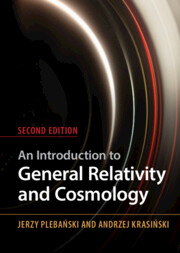Book contents
- Frontmatter
- Contents
- The scope of this text
- Preface to the second edition
- Acknowledgments
- 1 How the theory of relativity came into being (a brief historical sketch)
- Part I Elements of differential geometry
- Part II The theory of gravitation
- 12 The Einstein equations and the sources of a gravitational field
- 13 The Maxwell and Einstein–Maxwell equations and the Kaluza–Klein theory
- 14 Spherically symmetric gravitational fields of isolated objects
- 15 Relativistic hydrodynamics and thermodynamics
- 16 Relativistic cosmology I: general geometry
- 17 Relativistic cosmology II: the Robertson–Walker geometry
- 18 Relativistic cosmology III: the LemaÎtre–Tolman geometry
- 19 Relativistic cosmology IV: simple generalisations of L–T and related geometries
- 20 Relativistic cosmology V: the Szekeres geometries
- 21 The Kerr metric
- 22 Relativity enters technology: the Global Positioning System
- 23 Subjects omitted from this book
- 24 Comments to selected exercises and calculations
- References
- Index
22 - Relativity enters technology: the Global Positioning System
from Part II - The theory of gravitation
Published online by Cambridge University Press: 30 May 2024
- Frontmatter
- Contents
- The scope of this text
- Preface to the second edition
- Acknowledgments
- 1 How the theory of relativity came into being (a brief historical sketch)
- Part I Elements of differential geometry
- Part II The theory of gravitation
- 12 The Einstein equations and the sources of a gravitational field
- 13 The Maxwell and Einstein–Maxwell equations and the Kaluza–Klein theory
- 14 Spherically symmetric gravitational fields of isolated objects
- 15 Relativistic hydrodynamics and thermodynamics
- 16 Relativistic cosmology I: general geometry
- 17 Relativistic cosmology II: the Robertson–Walker geometry
- 18 Relativistic cosmology III: the LemaÎtre–Tolman geometry
- 19 Relativistic cosmology IV: simple generalisations of L–T and related geometries
- 20 Relativistic cosmology V: the Szekeres geometries
- 21 The Kerr metric
- 22 Relativity enters technology: the Global Positioning System
- 23 Subjects omitted from this book
- 24 Comments to selected exercises and calculations
- References
- Index
Summary
This is a brief description (following the work of N. Ashby) of the influence of relativistic effects on the working of the Global Positioning System. If these effects were neglected for 24 hours, the error in determination of the locator’s position would exceed 18 km.
- Type
- Chapter
- Information
- An Introduction to General Relativity and Cosmology , pp. 499 - 510Publisher: Cambridge University PressPrint publication year: 2024

